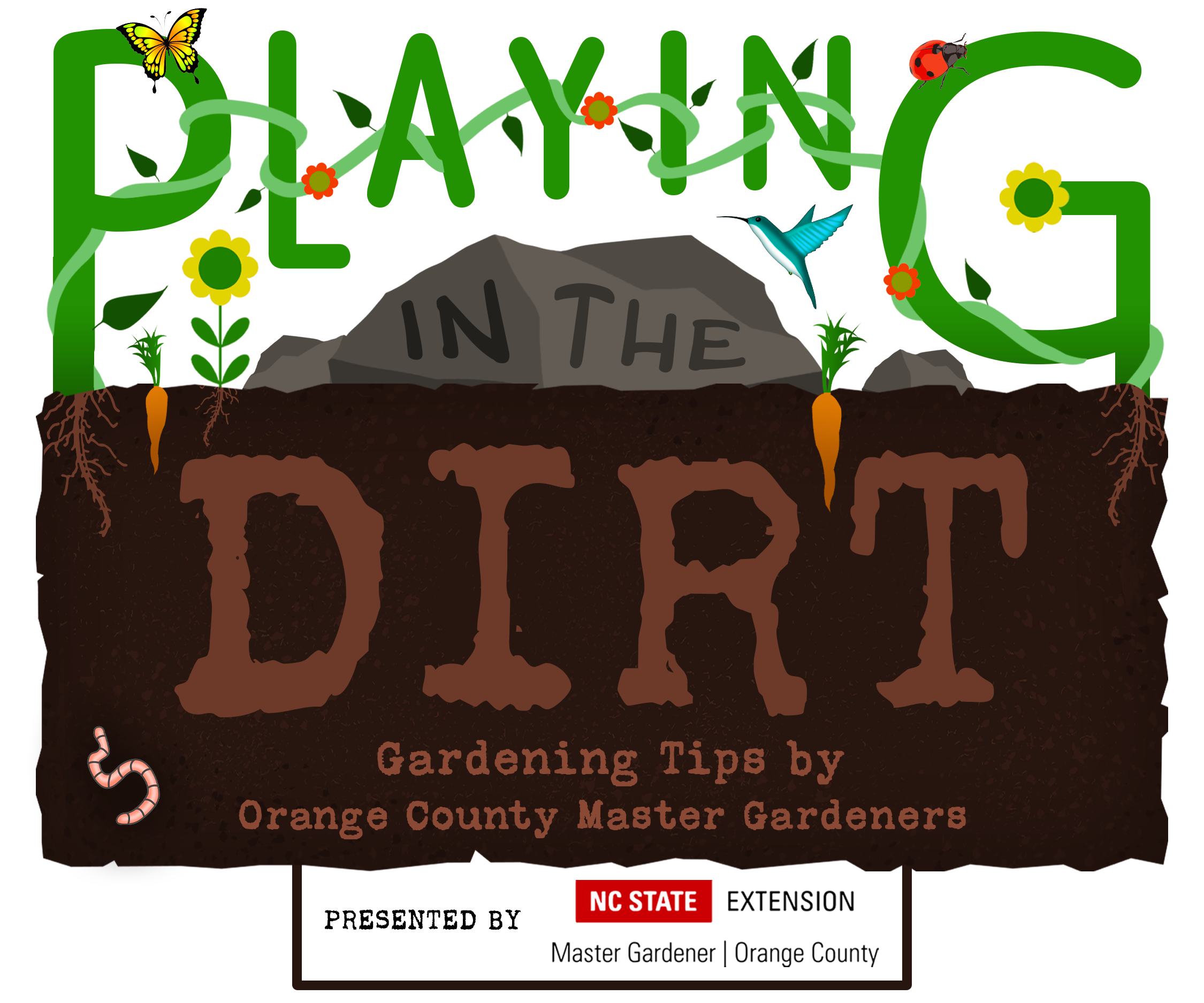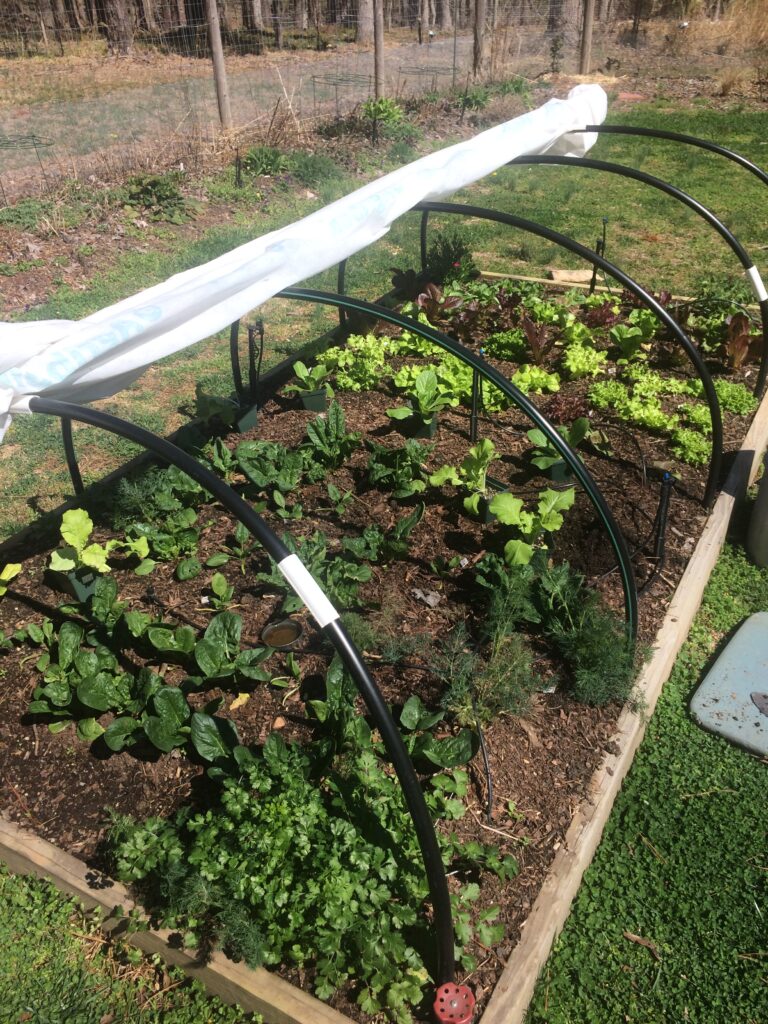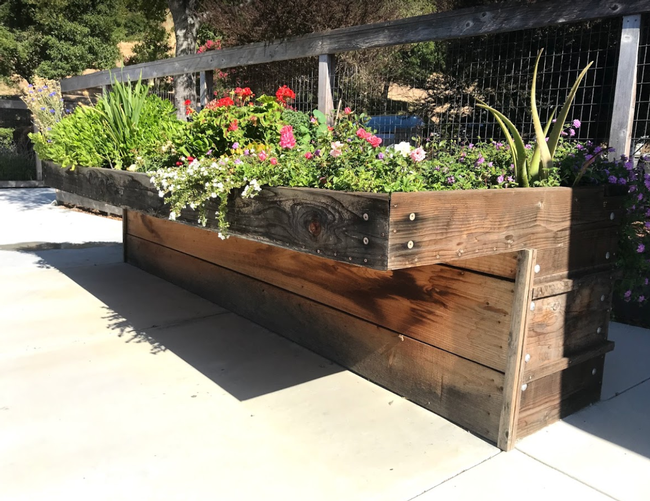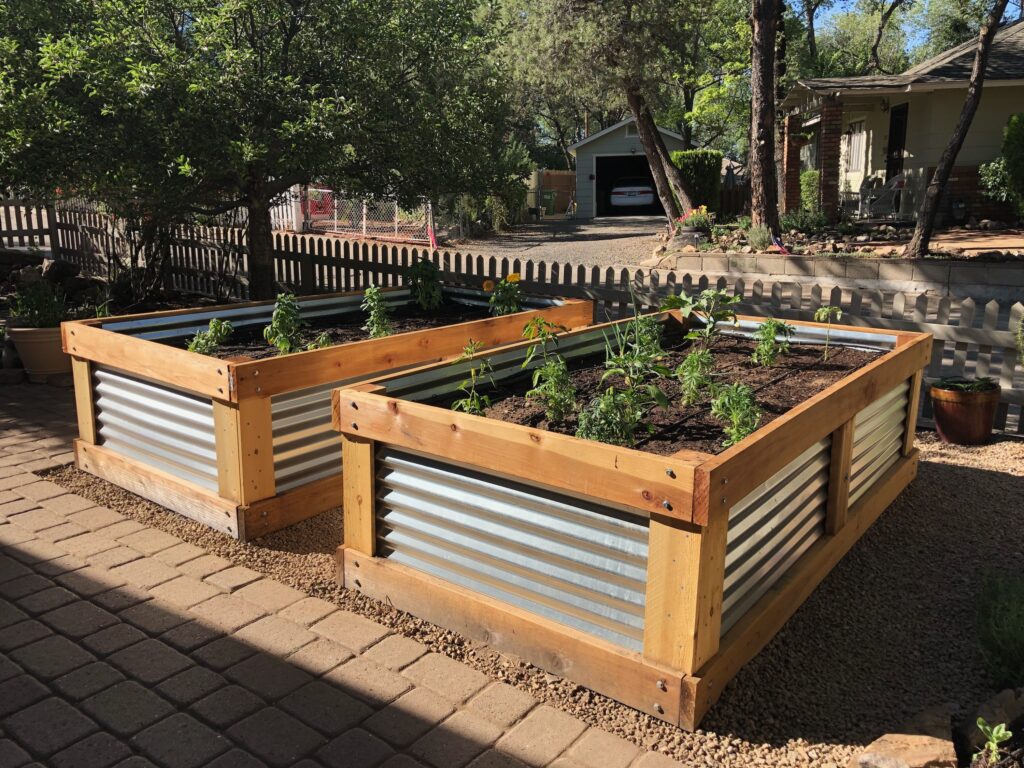
97.9 The Hill and Chapelboro.com have partnered with Orange County Master Gardeners for “Playing in the Dirt,” a monthly column exploring the fertile ground of home gardening in our community and intended to provide the information and inspiration gardeners of all skills levels need to flourish! Check back on Chapelboro each month for a new subject – from our gardens to yours!
By Anne C. Gardner, Orange County Master Gardener Volunteer
Do you have limited space for gardening? Is the soil in your yard that red clay that makes gardening such a headache in the Carolina Piedmont? Do you live in a new house on a site that has compacted soil from construction? Is it hard for you to bend over or otherwise tend a traditional in-ground garden? Raised garden beds and garden tables (also called salad tables) can make gardening easier for you. If you have a problem site or physical limitations that make gardening challenging, raised beds or garden tables may be the answer.
Raised beds and garden tables have other advantages:
- Better drainage. Some areas in your yard may drain poorly due to the soil quality and terrain. Raising the surface of the soil and using well-amended soil or potting mix in a raised bed makes good drainage possible.
- Longer growing season. Better drainage helps raised beds and garden tables warm up earlier in the spring, which means that seeds will germinate faster and transplants will grow better. You can also add hoops to support floating row covers for both raised beds and garden tables to extend the growing season even further.
- Higher yields. Because it’s easy to amend the soil or potting mix in your raised bed or garden table, you can plant more intensively — growing more plants in less space than in a conventional garden row. Square foot gardening is one popular intensive gardening method.
- Easier maintenance. Raised beds are designed so that walking on them is not necessary, reducing compaction. Weeding, watering and planting require less stooping. Tilling is not necessary in well-amended raised beds.
A raised bed is a gardening space whose surface is elevated above the ground. Most have sides added, with the bottom typically open to allow drainage. The sides of raised beds are often built of wood, but you can also build raised beds with concrete blocks, bricks, stones, metal, or synthetic lumber. Using recycled materials can save a lot of money, although you need to make sure the material you’re using is rot-resistant and safe for gardening. For example, railroad ties treated with creosote should not be used in a food garden. Read more about raised-bed construction materials in the North Carolina Extension Gardener Handbook.

This salad table has a DIY hardware cloth cover to discourage digging squirrels and plundering groundhogs. Photo by Anne C. Gardner.
A garden table is a shallow box on legs, most frequently made of wood. Garden tables typically have fiberglass screening and hardware cloth on the bottom or a solid base with holes for drainage. The box itself is only a few inches high (typically 4 to 6 inches), so the tables are appropriate for growing salad vegetables or other vegetables without deep roots. They’re great for growing lettuce, Swiss chard, kale, radishes and mustard greens. Garden tables have an advantage over raised beds in that you can add wheels to the legs and move them — to provide more or less sun to the table depending on the season and needs of the plants you’re growing, for example.
Site Selection
Selecting a site for a raised bed or garden table is similar to selecting a site for a conventional in-ground garden. Sunlight! Most vegetables require at least 6 hours of sunlight per day, although 8 to 10 hours is better. Some vegetables are more tolerant of shade, though, such as lettuce, parsley, kale, beets, carrots and radishes. Placing a bed or table near your home or other convenient area makes inspection and maintenance easier.
One downside to using raised beds and garden tables is that the soil may need more frequent watering and fertilizing than conventional in-ground beds. Easy access to an outdoor water faucet or irrigation saves the effort of carrying water to your plants. Adding a layer of mulch on top will help slow moisture loss. Installing a drip irrigation system can also save time and labor.

This raised bed’s row cover protects tender vegetables, but it can be pulled back to allow more light and ventilation. Photo by Dana Klimas.
Raised beds make gardening possible on a sloped site, although you may need to adjust the dimensions of a bed to accommodate the slope. On steeply sloped sites, you may need to hire landscaping professionals to excavate the flat areas and create a usable walkway.
Size Considerations
You can customize the height and width of your raised beds and garden tables. Raised beds can be any height to accommodate either plant or human needs. Most plant roots need at least 6 to 12 inches of soil. The soil in raised beds tends to dry out faster than ground-level beds — the deeper a raised bed, the more slowly the soil will dry. A 12-inch high bed can offer some relief for people who find bending uncomfortable, but a 36-inch high bed eliminates the need to bend. For wheelchair users, raised beds need to be around 24 inches tall, although this may vary with the height or age of the individual.
If you plan to access the raised bed from both sides, make it no wider than 3 to 4 feet. If children will be gardening in the bed, make it 3 feet wide so they can reach the center from either side. Garden tables are usually narrower than raised beds: 2 to 3 feet wide. Garden tables are great for wheelchair users because they can easily be built the right height, designed to allow knee clearance under the box and placed on an accessible surface. If you are building multiple raised beds or garden tables side by side, allow at least 24 inches between them for wheelbarrow access. For wheelchair users leave at least 48 inches between beds. Raised beds can be any length but remember that you’ll have to walk around the bed to get to the other side.

This raised bed is at a California residence for older adults. It is designed for easy access, including for people in wheelchairs. Photo by Julia van Soelen Kim, University of California Extension, Napa County.
You can purchase raised bed kits and garden tables online and at some local home and garden centers. You can also find raised bed corners and connectors that make construction easier. You can even buy commercial garden tables specifically designed for wheelchair users.
The Right Soil for Your Bed or Table
To fill raised beds, use topsoil well amended with organic matter or a commercial raised bed mix. There are no regulations regarding the sale of topsoil in North Carolina, so make sure you test any soil you purchase for garden use. See this NCSU Extension guide to soil testing for more information. If you use a commercial raised bed mix that’s a soilless mix, it will need a different type of test to determine how you need to amend it. See this guide to soilless media testing from the NC Dept. of Agriculture and Consumer Services.
Do not use topsoil in garden tables: topsoil is heavier than potting mixes and the table may not be able to support the weight of the damp soil. Potting mixes are a soilless mixture of organic and inorganic materials. You can buy mixes for specific plant needs; or mix your own from ingredients like sphagnum peat moss, coir, perlite and vermiculite.

A garden table placed in full sunlight. Photo by Gary Bachman, Mississippi State University Extension.
Additional Resources
If this article has whetted your appetite for raised beds and garden tables, check out the following links for more detailed information and instructions:
- Garden Types and Techniques (Raised Bed Gardens) (in Chapter 16, Vegetable Gardening, North Carolina Extension Gardener Handbook) (N.C. State University Extension).
- Raised Bed Planters (A North Carolina Community Food Gardening Handbook).
- Growing Vegetables in Salad Tables or Salad Boxes (University of Maryland Extension).
- Gardening for People with Disabilities (Christopher and Dana Reeve Foundation).
- Square Foot Gardening (University of Florida Gardening Solutions).
Check us out!
Have a plant or garden question for the Orange County Master Gardener volunteers? Email ocmgardeners@gmail.com or phone 919-245-2061.
The Orange County Master Gardener volunteers hope you’ll subscribe to The Garden Buzz, our new monthly newsletter that highlights local gardening news, events and tips. You can subscribe here. And please visit our website, The Orange Gardener.
Save the date: The Orange County Master Gardener volunteers will hold a plant sale and festival on Oct. 8, 9 a.m. to 2 p.m., at the Bonnie B. Davis Environmental and Agricultural Center, 1020 US 70 W, Hillsborough, NC 27278.
Chapelboro.com does not charge subscription fees, and you can directly support our efforts in local journalism here. Want more of what you see on Chapelboro? Let us bring free local news and community information to you by signing up for our biweekly newsletter.



